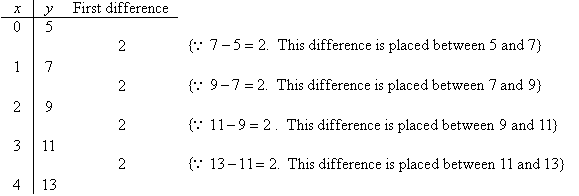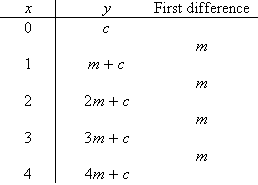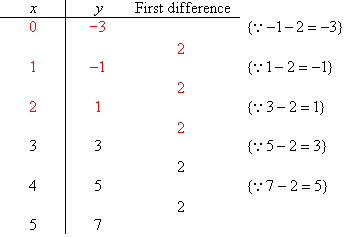Problem 4.2 Finite Difference Table
Consider a finite difference table of the linear function y = 2x
+ 5.

For the linear function y = 2x + 5, the first difference
in a finite difference table is constant and it is equal to 2. This
constant is the gradient of the linear function. When x = 0, y = 5. We can write this as y(0) = 5 which is the y-intercept.
Consider the finite difference table of the general linear
function y = mx + c where m is the gradient and c is the y-intercept.

Clearly, the first difference is the constant m; and it is the
gradient of the linear function.
y-intercept = y(0) = c.
From this we can infer that:
If a finite difference table for a function generates a constant
first difference, then it must be a linear function. Note that
if the table also includes x = 0, it allows us to easily find a
rule for the linear function.
Example 10
Find a rule for the function specified by the following table of
values:

Solution:

The first difference is constant. Therefore, the table of values
represents a linear function of the
form y = mx + c.
To find m and c, we compare this table with the finite
difference table of y = mx + c.


Note:
A table of values must include x = 0 as it helps to find the
value of c
Using a TI-83 Graphics Calculator
Clear any list(s) within the STAT menu
(and if there are graphs in memory clear them using the
Y = menu).
Select EDIT from the STAT menu and enter x values under L1 and y values under
L2. Both lists should have the
same number of entries.
Select Plot 1 on from the STAT
PLOT menu and turn the other plots off. Highlight the second
plot that gives a line graph. Choose L1 for the Xlist and L2 for the Ylist (if they are not already
highlighted).
Choose Zoom Stat from the ZOOM menu to obtain the graph of the data, which is a straight
line. Then choose LinReg in the CALC section of the STAT menu. The
screen display shows
that the relation

fits the data.
Example 11
Find a rule for the function specified by the following table of
values:

Solution:

The first difference is constant. Therefore, the table of values
represents a linear function of gradient 2. So, m = 2.
To find c = y(0) we extend the table as shown below.



Using a TI-83 Graphics Calculator
Clear any lists within the STAT menu (and
if there are graphs in memory, clear them using the
Y = menu).
Select EDIT from the STAT menu and enter x values under L1 and y values under
L2. Both lists should have the
same number of entries.
Select Plot 1 on from the STAT
PLOT menu and turn the other plots off. Highlight the second
plot that gives a line graph. Choose L1 for the Xlist and L2 for the Ylist (if they are not already
highlighted).
Choose Zoom Stat from the ZOOM menu to obtain the graph of the data which is a straight line.
Then choose LinReg in the CALC section of the STAT menu. The
screen display shows that the
relation

fits the data.
Just to recap:
For any linear function, the first difference in a finite difference
table is always constant. This constant is the gradient of the linear
function and the y-intercept is given by y(0).
Find a rule for the function specified by the following tables; and check
your answers with a graphics calculator.
|